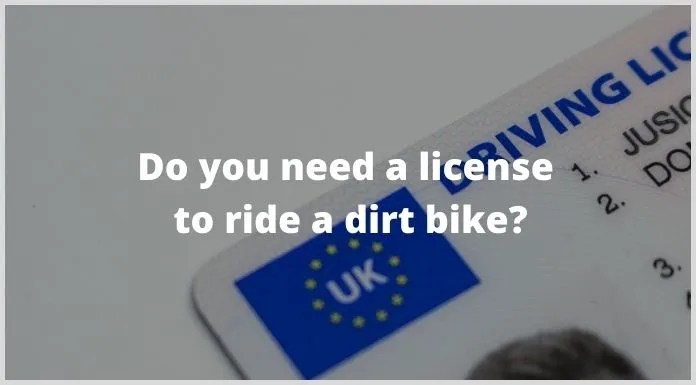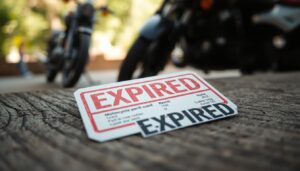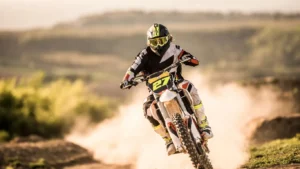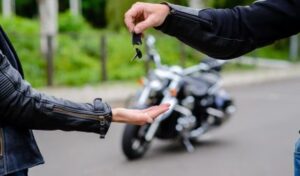I will tell you whether you need a license to ride a dirt bike if you are a beginner and want to know more about dirt bike permits. If you are a beginner and want to know more about dirt bike permits, then you are at the right place.
Even if you are bewildered by the various kinds of questions you have, such as:
- Where can I ride my dirt bike legally?
- What is a dirt bike permit?
- Can you ride dirt bikes in residential areas?
- What is the dirt bike license age?
Then you need to stay with this post and read it all the way through in order to comprehend these concepts.
Off-roading on your dirt bike does not require a license of any kind, nor is insurance of any kind required by law.
However, with that being said, many states—nearly half of all the states in the United States—require that children under the age of 18 be accompanied by an adult rider at all times.
In many states, having a spark arrestor installed on your motorcycle is a prerequisite for obtaining a license to operate the vehicle. There are also sound limitations in place at several additional locations.
If, on the other hand, you want to ride your dirt bike on the road, you will undoubtedly be required to have a license for that.
What is A Dirt Bike Permit?
Anywhere in the world, riding a motorcycle of any kind requires that you have a valid driver’s license or a dirt bike licence.
A dirt bike permit is necessary for riders under the age of 18 and for everyone else who rides a dirt bike. Before they may submit an application for a license, they first need to obtain a dirt bike permit.
In order to receive a license, one must first satisfy a minimum age requirement, which differs from one jurisdiction to another.
You may even be able to ride your dirt bike freely in certain areas without anyone having to ask for your license if you do so in such locations.
Where Can I Ride My Dirt Bike Legally?
Here’s a list of all such places;
1. Private property
If you happen to possess a private property that is large enough to ride on, there are virtually no rules that can ban you from doing so. You should only make sure to keep a low profile and avoid giving your neighbors any reason to complain.
Because not everyone shares your enthusiasm for the roaring sound of dirt bikers racing around with the throttle wide open. It’s possible that some of your neighbors value privacy and quiet above all else.
You don’t own any land or buildings like that? As long as you know someone who owns a property similar to that, it won’t be too much of a problem for you.
In addition, riding your bike on their private property is perfectly OK in his or her eyes, so don’t worry about offending them.
I’ve wrote an entire piece to the topic of riding dirt bikes on private land here. Click this link for further information on whether or not you are permitted to ride a dirt bike on your own land.
2. Local trails and state riding parks
It’s possible that the state in which you live has local trails or state riding parks where horseback riding is permitted. You might look about, or you could just ask your fellow riders if they know of any place like that.
Before you are able to ride to your heart’s content at many of these locations, you might be asked to become a member at those locations first.
If this is the case, it would be a wise decision to pay the membership fee because doing so would grant you unrestricted access to ride along in the park or on the route.
It’s possible that becoming a member is optional at some of these establishments. It’s possible that they will demand further documentation from you before they allow you ride.
The vast majority of parks and trails require visitors to sign up and bring the right safety gear. If you want your ride to go well and without any kind of interruption, you should probably bring them with you ahead of time.
3. Motocross Tracks
There are motocross courses in many places, including possibly your own state. You have to check things out first. Despite the fact that they might have certain demands of their own.
After you’ve met all of their requirements, you’ll be good to go, or ready to vroom. You should commit the dos and don’ts to memory because you probably wouldn’t like it if you were kicked from the motocross course after your very first attempt (Yes, some people are that strict on rules)
In the event that you discover a location. You, my friend, ought to be looking for a long term relationship, and you shouldn’t throw away your chances by disobeying the rules of the site where you’re looking for one.
Also, what else? Getting along with the manager of a place could lead to more benefits for you, like unrestricted access and a more flexible interpretation of rules that you don’t like.
In the case that you are interested in constructing your very own motocross track, you will require extensive information; thus, I am providing you with the following post, in which I will explain how to build a motocross track.
4. Forest trails, mountain roads, dunes and deserts
If you are fortunate enough to find a sign that reads “Off-Highway Vehicle” or something along those lines, it indicates that you are permitted to ride your dirt bike in that area.
Depending on where you live, these regions could consist of a hiking path through the woods, a road that winds through the mountains, sand dunes, or desert.
Because there is little to no interruption from other people in these types of locations, you are free to ride your bike for as long or as quickly as you wish. This is a very desirable quality.
However, take care not to do any harm on any of the forms of local animals that you could come across. Especially while you are riding through woodland paths, as this could get you in trouble with the authorities that are in charge of those areas.
The presence of many different kinds of natural impediments is just another advantage of these kinds of locations. You will come upon a log or a boulder that is strewn about, and in order to proceed, you will need to navigate around it.
In this respect, sand dunes and deserts present a lower risk than other types of terrain, as people are less likely to come into contact with local fauna there.
It is strongly recommended that you continue to ride in a safe manner while utilizing all of the required safety gear.
Because there aren’t that many people living in the area, it’s possible that if there’s an emergency, no one will even notice. Especially so when you are actually traveling. You must always be alert and safe.
5. Rural areas
Be as unconcerned as possible; the United States does, in fact, contain rural areas.
You will need to do some research to find remote rural areas that have a sparse human population, as these are the only places where you will be able to ride your dirt bike freely without running afoul of the law.
It’s possible that you won’t run into any issues if you ride your dirt bike here for leisure purposes.
Can You Ride Your Dirt Bike in Residential Areas?
No, you can’t ride your dirt bike in residential areas.
At the very least, not without first making the mandatory adjustments required by the legislation. Before you can do that, you need to make sure that your bicycle is allowed to be ridden on the street.
In this particular scenario, there is no single rule that is applicable to everyone. The laws and regulations are different from one state to the next. First, you need to complete everything on the checklist, and then you can receive the proper driver’s license.
Also, if you want to ride your bike anywhere, you need to get a license plate for it first. You are required to have a license plate, and you must attach it to the front of the motorcycle. You won’t have to worry about renewing it every year.
Keep in mind that you also need to have insurance to ride your bike anywhere other than private properties.
The most fundamental needs for every insurance policy are public liability and public damage coverage. Operating a motorcycle without proper insurance can result in a fine that can go up to $5,000 in some cases. That’s not a typo; you read that correctly—$5000!
That is the number of fines that can be received in certain jurisdictions such as Ontario.
You are free to ride your motorcycle on public roads once you have obtained a license plate, a riding license, insurance, and made any necessary modifications to your motorcycle. Does that sound like a hell of a lot of effort to you? Absolutely, that is the case.
But the government takes steps to make it hard for off-road vehicles to get permission to drive on public roads.
Despite the fact that the law enforcement officer is willing, he will not give you permission to ride your bike on the street.
I hope the response to your question has been helpful to you.
RIDE SAFE






